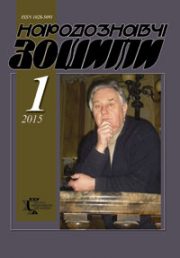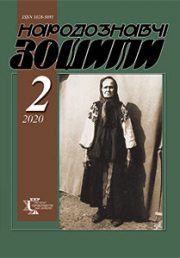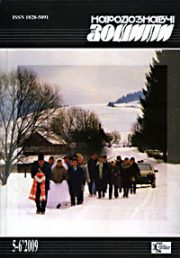The Ethnology Notebooks. 2018, 6 (144), 1385–1393
UDK 766:7.012-027.3(477)
DOI https://doi.org/10.15407/nz2018.06.1385
Received 21.11.2018
ORCID ID: https://orcid.org/0000-0002-8826-0135
Kosiv Vasyl Mykhailovych, Candidate of Art Studies, Associate Professor,
The Department of Graphic Design,
Lviv National Academy of Arts.
38 Kubiiovycha Str., 79011, Lviv, Ukraine.
Contacts: vasylkosiv@yahoo.com
Abstract. Based on the examples of graphic design of the Ukrainian diaspora from 1945—1989, the combination of religious and national symbols in visualizing Ukrainian identity have been analyzed. Covers of periodicals, postcards, commissioned by secular organizations, show how religious symbols accompanied visual messages about Ukraine and Ukrainians. On the other hand, in church publications, national symbols supplemented communication on religious themes. Such mutual penetration of symbolism reflected the Christian education of the authors and their audience, the practice of defining national history with religious metaphors, as well as the generally acknowledged mission of both Ukrainian Orthodox and Ukrainian Catholic churches of national identity preservation and the upbringing of patriotism in the community. For the Ukrainian diaspora, national aspects of the church life often predominated over the confessional, almost all misunderstandings and conflicts concerned the Ukrainian character of the Church. In their graphic design, Mykhailo Dmytrenko, Mykhailo Mykhalevych, Myron Levytsky, Mykola Butovych, Petro Andrusiv, Leonid Denysenko, and other authors modify established iconographic schemes and create new ones. It is noted that the most fruitful period of the construction of hybrid symbols was the preparation for the 1000th anniversary of the Christianity in Ukraine (1988) when numerous combinations of the trident and the cross appeared. Most examples show that the unique messages are constructed not so much by the semantics of the symbols (which were quite common), but with the syntax of visual communication, that is, their combinations. It is revealed that among all the visual features of Ukrainian identity in graphic design, the religious aspect evokes the greatest difference between the works of Soviet Ukraine and the Ukrainian diaspora.
Keywords: religious and national symbols, Ukrainian identity, graphic design, Ukrainian diaspora.
REFERENCES
From the Address of His Most Reverend Excellency Archbishop Hryhoriy of The Ukrainian Autocephalous Orthodox Church and The Head of the Ukrainian Orthodox Church abroad, presented in Chicago on July 28th, 1951, on the day of Equal Apostles Volodymyr (Ch. 3, pp. 1–2) [in Ukrainian].
Veryha, V. (1966). The Role of the Church in the upbringing of a Ukrainian person. For the Native Church. Official Bulletin of the Committee of Defense of the Rite and Traditions of the Ukrainian Catholic Church in Canada (Ch. 2—3, pp. 11—18) [in Ukrainian].
Anderson, B. (1999). The Goodness of Nation. In P. van Der Veer and H. Lehmann (Ed.) Nation and Religion: Perspectives on Europe and Asia (pp. 197—203). Princeton: Princeton University Press.
Van der Veer, P. and Lehmann, H. (1999). Introduction In P. van Der Veer and H. Lehmann (Ed.) Nation and Religion: Perspectives on Europe and Asia (pp. 3—14). Princeton: Princeton University Press.
Mayer, T. (2005). Representation and Collective Memory. In M.E. Geisler (Ed). National Symbols, Fractured Identities: Contesting the National Narrative (pp. 3—34). Middlebury, Vermont: Middlebury College Press.
Stites, R. (2005). Russian Symbols — Nation, People, Ideas. In M.E. Geisler (Ed). National Symbols, Fractured Identities: Contesting the National Narrative (pp. 101—117). Middlebury, Vermont: Middlebury College Press.
Pasternak, Ya. (1941). Explanation of trident, coat of arms of Kyiv Prince Volodymyr The Great. Prague: Proboyem [in Ukrainian].
Andrusiak, M. (1947). Trident. N. d.: Vernyhora Soc. [in Ukrainian].
Kushchynskyi, A. (1983). State coat of arms of christian Ukraine. Chicago: Ukrainian Free Cossacks [in Ukrainian].
Kostomarov, M. (N. d.). Two Rus Nations. Leipzig: Ukrainian Publishing [in Ukrainian].
Lypynskyi, V. (1925). Religion and church in the history of Ukraine. Philadelphia: America [in Ukrainian].
Mirchuk, I. (2006). Worldview of the Ukrainian nation: an attempt of characteristic. In M. Shafoval and R. Yaremko (Ed.). Ivan Mirchuk. Philosophy Studies (pp. 383—407). Munich: Ukrainian Free University [in Ukrainian].
Yaniv, V. (1966). Religiosity of a Ukrainian from the ethnopsychology viewpoint. Religion in the life of Ukrainian People. Collection of Papers of the Scientific Conference in Rocca di Papa (Nov. 18—20, 1963). Papers os Shevchenko Scientific Society (Vol. 181, pp. 179—203). Munich-Rome-Paris: NTSh, UBNT, UVAN, UVU [in Ukrainian].
Armstrong, J.A. (1990). Ukrainian Nationalism. Englewood, Colorado: Ukrainian Academic Press.
Lysiak-Rudnytskyi, I. (1994). What to do? In I. Lysiak-Rudnytskyi. Historical Essays (Vol. 2. pp. 437—456). Kyiv: Osnovy [in Ukrainian].
Rudnytska, M. (1998). All-national or confessional institutions? In M. Diadiuk (Ed.). Milena Rudnytska. Articles. Letters. Documents. Collection of documents and materials on life, social and political activity, and journalism of Milena Rudnytska (pp. 160—163). Lviv: Central State Historical Archive of Ukraine [in Ukrainian].
Kachmar, V. (V. K.) (1978). Why, when, and where Ukrainian patriarchate movement emerged? Patriarchate, 2 (80), 13—14 [in Ukrainian].
Andrushkiv, V. (1972). Letter to the Holy Father Pope of Rome, November 30, 1971. Archive of the Ukrainian Museum and Library in Stamford. F. 1. Vol. 6. P. 1—2 [in Ukrainian].
Documentation from Cleveland. (1966). For the Native Church. Official Bulletin of the Committee of Defense of the Rite and Traditions of the Ukrainian Catholic Church in Canada, 4—5, 6—37.
Teodorovych, I. (1969). Interview (Audio). Archives of The Ukrainian History and Education Center (New Jersey). F. Mykola Francuzenko Papers. Metr. Ioan (Teodorovych) interview. Voice of America, 1969.
OSIDU. (1970, january). Samobutnia Ukraina (Ch. 37, pp. 149—150) [in Ukrainian].







